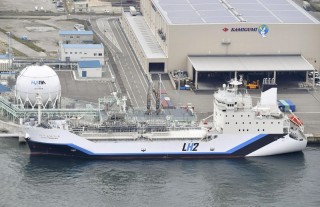Loading
Search
▼ World’s First Liquefied Hydrogen Carrier To Be Tested By Japanese Firms
- Category:Other
KOBE — A group of Japanese companies will launch a feasibility test during fiscal 2021 for the transport of hydrogen from Australia using the world’s first liquefied hydrogen carrier.
The new hydrogen tanker Suiso Frontier was unveiled to the press at Kobe Port Island in Kobe on May 24. It is 116 meters long, 19 meters wide and weighs about 8,000 tons in gross tonnage.
The Suiso Frontier was built by Kawasaki Heavy Industries Ltd. and is equipped with a specially constructed tank that can store hydrogen by cooling it to minus 253 C and reducing its volume to 1/800.
The hydrogen will be extracted from coal mined in Australia, and after being liquefied, it will be transported by the Suiso Frontier to Kobe.
The liquefied hydrogen will be stored at a facility on Kobe Port Island that will have a storage capacity equivalent to that needed for about 30,000 hydrogen-powered fuel cell vehicles.
During the test, the safety of transportation and storage will be verified in order to establish a supply chain for liquefied hydrogen, as an effort toward the decarbonization of domestic industries.
“We want to make Kobe a leading location for hydrogen energy,” said Motohiko Nishimura, an executive officer of KHI.
For now, the Suiso Frontier is powered by heavy fuel oil. However, the company is developing an engine for ships that runs on gasified hydrogen, and plans to begin tests in 2025 to run small and midsize ships on the engine, it announced Tuesday. KHI said that it is also aiming to build large ships of that type after 2026.
Seven companies will participate in the test for the transport from Australia, including KHI and major industrial gas company Iwatani Corp. The latter will be involved in development of hydrogen stations for fuel cell vehicles.
The test is truly a national project, supported by the New Energy and Industrial Technology Development Organization, an agency under the jurisdiction of the Economy, Trade and Industry Ministry. It was originally scheduled to start in fiscal 2020, but was postponed due to the coronavirus crisis.
The ministry estimates that once the supply network for marine transportation is commercialized, the cost of hydrogen per cubic meter will drop from the current level of about ¥100 to about ¥30 by around 2030. It envisions a future in which the cost will be reduced to less than ¥20 by 2050, making it equivalent to liquefied natural gas.
The hydrogen to be imported from Australia is refined from low-grade coal lignite, which will bring the advantage of supplying hydrogen at a lower cost than producing it in Japan, because lignite is inexpensive.
“If the cost comes down, hydrogen energy will become more widespread in areas such as power generation,” said a senior official of the ministry.
The new hydrogen tanker Suiso Frontier was unveiled to the press at Kobe Port Island in Kobe on May 24. It is 116 meters long, 19 meters wide and weighs about 8,000 tons in gross tonnage.
The Suiso Frontier was built by Kawasaki Heavy Industries Ltd. and is equipped with a specially constructed tank that can store hydrogen by cooling it to minus 253 C and reducing its volume to 1/800.
The hydrogen will be extracted from coal mined in Australia, and after being liquefied, it will be transported by the Suiso Frontier to Kobe.
The liquefied hydrogen will be stored at a facility on Kobe Port Island that will have a storage capacity equivalent to that needed for about 30,000 hydrogen-powered fuel cell vehicles.
During the test, the safety of transportation and storage will be verified in order to establish a supply chain for liquefied hydrogen, as an effort toward the decarbonization of domestic industries.
“We want to make Kobe a leading location for hydrogen energy,” said Motohiko Nishimura, an executive officer of KHI.
For now, the Suiso Frontier is powered by heavy fuel oil. However, the company is developing an engine for ships that runs on gasified hydrogen, and plans to begin tests in 2025 to run small and midsize ships on the engine, it announced Tuesday. KHI said that it is also aiming to build large ships of that type after 2026.
Seven companies will participate in the test for the transport from Australia, including KHI and major industrial gas company Iwatani Corp. The latter will be involved in development of hydrogen stations for fuel cell vehicles.
The test is truly a national project, supported by the New Energy and Industrial Technology Development Organization, an agency under the jurisdiction of the Economy, Trade and Industry Ministry. It was originally scheduled to start in fiscal 2020, but was postponed due to the coronavirus crisis.
The ministry estimates that once the supply network for marine transportation is commercialized, the cost of hydrogen per cubic meter will drop from the current level of about ¥100 to about ¥30 by around 2030. It envisions a future in which the cost will be reduced to less than ¥20 by 2050, making it equivalent to liquefied natural gas.
The hydrogen to be imported from Australia is refined from low-grade coal lignite, which will bring the advantage of supplying hydrogen at a lower cost than producing it in Japan, because lignite is inexpensive.
“If the cost comes down, hydrogen energy will become more widespread in areas such as power generation,” said a senior official of the ministry.
- June 5, 2021
- Comment (0)
- Trackback(0)


